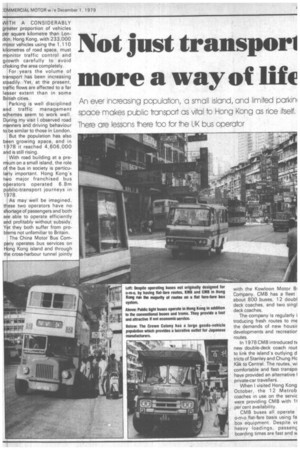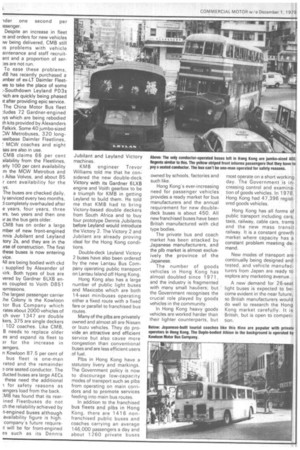Not just transpori more a way of lift
Page 47

Page 48

If you've noticed an error in this article please click here to report it so we can fix it.
An ever increasing population, a small is and, and imited par Mere are lessons there too for the UK bus operator i/VITH A CONSIDERABLY grater proportion of vehicles par square kilometre than Lon&In, Hong Kong, with 233,000 m tor vehicles using the 1,110 ki dmetres of road space, must monitor traffic control and g owth carefully to avoid c oking the area completely. For years the volume of tr nsport has been increasing steadily. Yet, at the present, traffic flows are affected to a far lesser extent than in some British cities. Parking is well disciplined and traffic management schemes seem to work well. During my visit I observed road manners and driving behaviour to be similar to those in London. But the population has also been growing apace, and in 1978 it reached 4,606,000 arid is still rising. With road building at a premium on a small island, the role of the bus in society is particularly important. Hong Kong's tWo major franchised bus operators operated 6.8m public-transport journeys in 1978. As may well be imagined, these two operators have no shortage of passengers and both a e able to operate efficiently a d profitably without subsidy. Y t they both suffer from pro b ems not unfamiliar to Britain. The China Motor Bus Comp ny operates bus services on H ng Kong island and through t e cross-harbour tunnel jointly with the Kowloon Motor Bi Company. CMB has a fleet about 800 buses, 12 doubl deck coaches, and two singl deck coaches. The company is regularly i troducing fresh routes to me the demands of new housir developments and recreatior routes. In 1978 CMB introduced tv new double-deck coach rout to link the island's outlying d tricts of Stanley and Chung Hc Kak to Central. The routes, wi comfortable and fast transpo have provided an alternative i private-car travellers. When I visited Hong Kong October, the 12 Metrob coaches in use on the servic were providing CMB with 11 per cent availability. CMB buses all operate o-m-o flat-fare basis using fa box equipment. Despite vE heavy loadings, passenc, boarding times are fast and sA -ider one second per issenger. Despite an increase in fleet !e and orders for new vehicles )w being delivered, CMB still is problems with vehicle aintenance and staff recruitent and a proportion of setes are not run. To ease these problems, AB has recently purchased a imber of ex-LT Daimler Fleetres to take the place of some :-Southdown Leyland PD3s lich are quickly being phased it after providing epic service, The China Motor Bus fleet 3ludes 72 Gardner-engined iys which are being rebodied th kits provided by Alexanders Falkirk. Some 40 jumbo-sized Metrobuses, 320 longieelbase Daimler Fleetlines, MCW coaches and eight sas are also in use. CMB claims 66 per cent ailability from the Fleetlines, arty 100 per cent availability m the MCW Metrobus and Ailsa Volvos, and about 85 r cent availability for the ys. The buses are checked daily, ly serviced every two months, icompletely overhauled after e years, four years, three )rs, two years and then one tr as the bus gets older. CMB has on order a large mber of new front-engined nnis Jubilant and Leyland tory 2s, and they are in the irse of construction. The first these buses is now entering vice. 411 are being bodied with ckd ; supplied by Alexander of Ihe largest passenger carrier :he Colony is the Kowloon tor Bus Company which rates about 2000 vehicles of ch over 1347 are double kers, 375 are single deckers 102 coaches. Like CMB, B needs to replace older es and expand its fleet to 3 r for the increase in -iengers. n Kowloon 87.5 per cent of bus fleet is one-man rated and the remainder a one seated conductor. The ducted buses are large AECs these need the additional -; for safety reasons as iengers load from the back. :MB has found that its rearmed Fleetbuses do not eh the reliability achieved by t-engined buses although availability figure is high. company's future require,/ will be for front-engined es such as its Dennis Jubilant and Leyland Victory machines. KMB engineer Trevor Williams told me that he considered the new double-deck Victory with its Gardner 6LXB engine and Voith gearbox to be a triumph for KMB in getting Leyland to build them. He told roe that KMB had to bring Victory-based double deckers from South Africa and to buy four prototype Dennis Jubilants before Leyland would introduce the Victory 2. The Victory 2 and Jubilant are already proving ideal for the Hong Kong conditions. Double-deck Leyland Victory 2 buses have also been ordered by the new Lantau Bus Company operating public transport on Lantau Island off Hong Kong. Hong Kong also has a large number of public light buses and Maxicabs which are both 14-seat minibuses operating either a fixed-route with a fixed fare or parallel to franchised bus routes. Many of the plbs are privately owned and almost all are Nissan or lzuzu vehicles. They do provide an attractive and efficient service but also cause more congestion than conventional buses and are less efficient users of fuel. Plbs in Hong Kong have a statutory livery and markings. The Government policy is now to discourage low-capacity modes of transport such as plbs from operating on main corridors and to promote services feeding into main bus routes. In addition to the franchised bus fleets and plbs in Hong Kong, there are 1416 nonfranchised public buses and coaches carrying an average 146,000 passengers a day and about 1260 private buses owned by schools, factories and such like. Hong Kong's ever-increasing need for passenger vehicles provides a ready market for bus manufacturers and the annual requirement for new doubledeck buses is about 450. All new franchised buses have been British manufactured with ckd type bodies. The private bus and coach market has been attacked by Japanese manufacturers, and the plb market is almost exclusively the province of the Japanese. The number of goods vehicles in Hong Kong has almost doubled since 1971, and the industry is fragmented with many small hauliers; but the Government recognises the crucial role played by goods vehicles in the community. In Hong Kong heavy goods vehicles are worked harder than their lighter counterparts, but most operate on a short working day. The Government is increasing control and examination of goods vehicles. In 1978, Hong Kong had 47,396 registered goods vehicles. Hong Kong has all forms of public transport including cars, taxis, railway, cable cars, trams and the new mass transit railway. It is a constant growth market where capacity has a constant problem meeting demand. New modes of transport are continually being designed and tested, and vehicle manufacturers from Japan are ready to explore any marketing avenue. A new demand for 26-seat light buses is expected to be come evident in the near future, so British manufacturers would do well to research the Hong Kong market carefully. It is British, but is open to competition.
















































































































